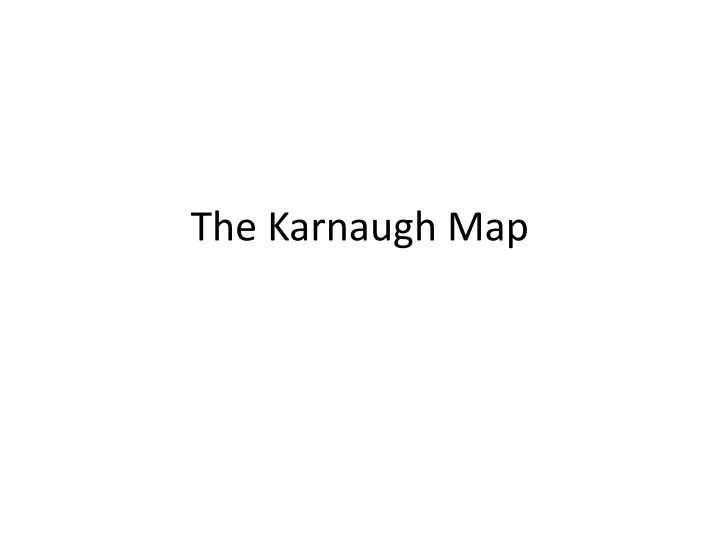
Simplify Digital Circuits with Karnaugh Maps and Logic Functions
Master simplifying digital circuits with Karnaugh maps. Learn to reduce terms, create logic functions, and optimize circuits efficiently. Explore examples of K-maps for various exercises and discover how to implement functions with simpler circuits.
Uploaded on | 0 Views
Download Presentation

Please find below an Image/Link to download the presentation.
The content on the website is provided AS IS for your information and personal use only. It may not be sold, licensed, or shared on other websites without obtaining consent from the author. If you encounter any issues during the download, it is possible that the publisher has removed the file from their server.
You are allowed to download the files provided on this website for personal or commercial use, subject to the condition that they are used lawfully. All files are the property of their respective owners.
The content on the website is provided AS IS for your information and personal use only. It may not be sold, licensed, or shared on other websites without obtaining consent from the author.
E N D
Presentation Transcript
K-map rules Draw the K-map. Remember to make sure that the adjacent rows/columns differ by only one bit. According to the truth table, write 1 in the boxes. Draw a circle around a rectangle with all 1s. The rectangle must have size 1,2,4,8,16 Then, reduce the terms by writing down the variables whose values do not change in the circle. For example, if there is a rectangle with two 1s representing ab c and ab c, you write a term as ab . Note that A term may be covered in multiple circles! The rectangle can wrap-around! Simplify to the simplest circuits possible: Try to get a circle as large as possible. Try to get the minimum number of circles.
K-map for exercise 1 K-map X2 X1 X0 output 0 0 0 1 x2x1 0 0 1 1 10 x0 01 11 00 0 1 0 1 1 1 0 0 0 1 0 1 1 1 1 1 0 0 1 0 0 0 Y = X2 Because x1 and x0 both take different values in some boxes in the circle, while x2 is 0 in all such boxes 1 0 1 0 1 1 0 0 1 1 1 0
K-map for exercise 2 K-map x2x1 x0 X2 X1 X0 output 0 0 0 0 10 01 11 00 0 0 1 1 1 1 0 0 0 1 0 1 0 0 1 1 1 1 0 1 1 1 1 0 0 0 Y = X0 Because x2 and x1 both take different values in some boxes in the circle, while x0 is 1 in all such boxes 1 0 1 1 1 1 0 0 1 1 1 1
Simplifying Digital Circuits Reconsider the 1-bit full adder. The carry bit is But we can implement the function with a much simpler circuit: How to get there?
K-map for CO K-map ab c 00 01 10 11 0 0 1 0 0 1 0 1 1 1 CO = ab + ac + bc Notice that the 111 box is covered 3 times!
K-map F=a bc +a bc+a b c+ab c ab c 00 01 10 11 0 1 0 0 0 1 1 1 0 1
K-map F=a bc +a bc+a b c+ab c ab c 00 01 10 11 0 1 0 0 0 1 1 1 0 1 F=a b+b c Notice the wrap around!
K-map F=a bc +a bc+abc +abc+a b c ab c 00 01 10 11 0 1 1 0 0 1 1 1 1
K-map F=a bc +a bc+abc +abc+a b c ab c 00 01 10 11 0 1 1 0 0 1 1 1 1 F=b+a c
K-map F=a bc d+a bcd+abc d+abcd+a b c d+abcd ab cd 00 01 10 11 00 01 1 1 1 11 1 1 10 1
K-map F=a bc d+a bcd+abc d+abcd+a b c d+abcd ab cd 00 01 10 11 00 01 1 1 1 11 1 1 10 1 F=bd+a c d+abc
Simplifying digital circuit There are many methods. Using boolean algebra Using K-map By just being really smart
Boolean Algebra Laws A+A=A, A*A=A 14
Boolean Algebra To use Boolean algebra, note that CO= abc +ab c+a bc+abc Now, abc +abc=ab(c +c)=ab. ab c+abc=ac(b +b)=ac a bc+abc=bc(a +a)=bc We used term abc three times because abc=abc+abc+abc!
K-map It is actually more convenient to use K-map to simplify digital circuits. K-map is a very mechanical procedure. Nothing fancy. It basically uses two rules: A+A=A, and AB+AB =A.
Exercise Design a selector? Design a circuit that takes two input bits, a and b, and a selector bit s. The function is that if s=0, f=a. if s=1, f=b.
Selector s a b f 0 0 0 0 0 1 0 1 0 0 1 1 1 0 0 1 0 1 1 1 0 1 1 1
Selector s a b f 0 0 0 0 0 0 1 0 0 1 0 1 0 1 1 1 1 0 0 0 1 0 1 1 1 1 0 0 1 1 1 1
K-map F=s ab +s ab+sa b+sab sa b 00 01 10 11 0 1 0 0 0 1 1 1 1
K-map F=s ab +s ab+sa b+sab sa b 00 01 10 11 0 1 0 0 0 1 1 1 1 F=s a+sb
